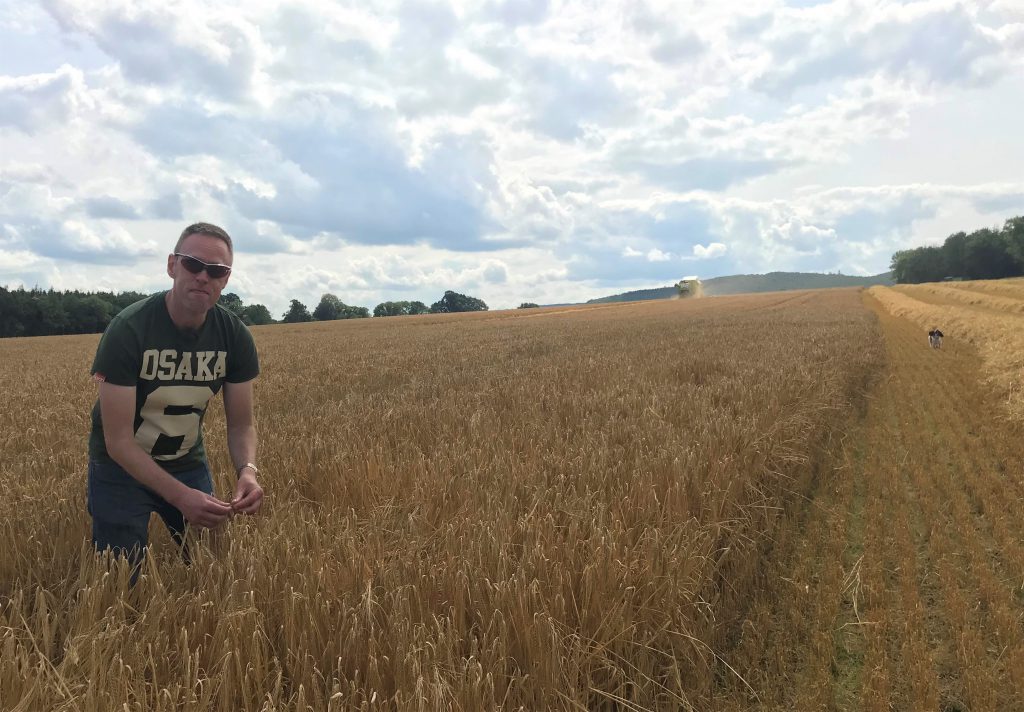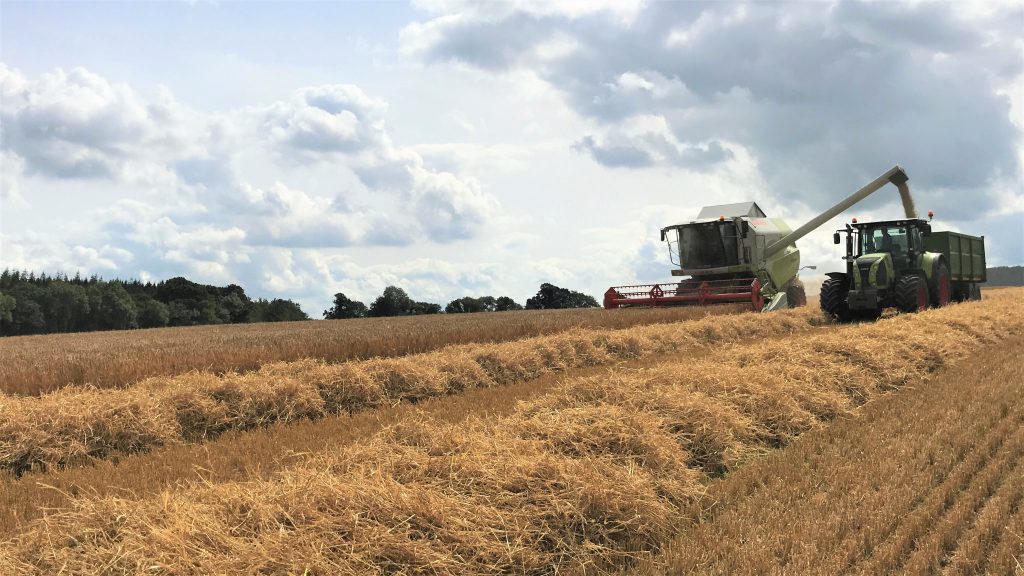Over the Christmas period, there’s no doubt a few people will enjoy the products from David Walsh Kemmis’s farm. Back in August, AgriLand popped in to see some of the harvest on Ballykilcavan Farm, just outside Stradbally in Co. Laois.
It’s a fairly unique place. Some day David may be able to walk into his local public house and order a pint of his own beer – made from his barley and hops – and finish with a short of whisky produced from barley grown on his farm.
The distilling crop of Laureate spring barley was destined for Waterford Distillery, but would first be stored in Daltons Chancellor’s Mills and David was heading to load a lorry after speaking with AgriLand.
Local man Willie Deegan was on combine duty and David was glad to be cutting, as heavy rain was due that night.
“That’s Laureate. I’d be worried about it standing; it’s already lying over a little bit. If it got 30ml of rain I’d be worried about it.”
A hand sample from the field the night before cutting showed a protein content of 7.8%, so David was confident of making the distilling grade.
The crop was sown early – February 27 – so this no doubt contributed to the low-protein content. Due to a break in weather the brewing crop – of Planet – was sown three weeks later than this.
Growing for Waterford Whisky from the start
David has been growing barley to produce ‘Waterford Whisky’ since the project began in 2015. In that year, he won the company’s ‘Best Barley Grower of the Year’ title, for which he received a blood tub of his own spirit, but he won’t get hold of this until that spirit passes the three-year mark and is officially whisky.
It is clear from talking to David that he is enthused – he asked to become a supplier at the beginning of the project.
“We’ve grown for Waterford for five years. Last year it didn’t pass; it was 12% protein. I find it really interesting. You don’t get paid anymore for it; it’s exactly the same as if it were going for general distilling.
I rang up and asked could I be a part of this when I heard it was going on, because you don’t get to go into anywhere else – see your barley being processed and put through the distillery.
“They invite you down. You can see it, taste it and do the cut to hearts. You don’t get to do that anywhere else. Hopefully next year we’ll have whisky,” David added.
What’s so special about ‘Waterford Whisky’?
Waterford Distillery uses barley from about 35 growers across the country each year. This grain is stored, malted and then distilled separately. Everything about the process is fully traceable. The company hopes to build up a range of different whiskys which will taste differently depending on factors such as soil type and climate.
“They may or they may not do single farm releases. The great thing about what they’re doing is they can do single farm releases; they could do a Laois versus Wexford release; a sandy soil versus a heavy soil.”
David tasted his whisky straight off the still and was able to compare it to the previous year’s whisky. While he admits he isn’t a whisky buff he did notice a difference from one year to the next.
On one occasion, David tasted whisky from a heavy soil and a light soil.
“There was a huge difference – one was quite floral and there were different aromas off it. The other one was a little bit dull and heavy.”
Brewing barley for beer
In the same field lies 3ha of Planet malting barley for brewing. This crop will produce approximately 24t and keep David’s brewery running for most of the year. Another crop is located beside the brewery.
In the first few years of production David was brewing his beer off the farm, but he completed work on the brewery last December and now produces beer on site.
“We’re brewing away since December. Production is up 20% this year compared to previous years. We’ve a lot more capacity than we can use. The distribution of it is the really tricky bit.

Niall Clancy was drawing in the grain. Niall is the third generation of his family to work on the farm
“It’s a hard business to crack because you’re dealing with the other micro breweries, but you’re dealing with the big guys. You’re trying to get in against Heineken and Diageo.”
As a result, David is expanding his markets and will travel to the south of France in the autumn to generate leads in that region.
“We have a good local market, but what we actually need is to expand more nationally, or what we’re looking at at the minute is export. We have beer going into the UK in about six weeks.”
Local ingredients – the highest quality
As a farmer David gets a kick from brewing his own barley and seeing it make whisky. He is sure of the quality of the ingredients in the product.
“It’s back to local beer and local ingredients. We produce really good malting barley in this country so let’s focus on the fact that we’re using top-quality Irish barley.
“The craft beer thing in America is very much based around hops because they have very good hops over there and that’s what they’re using as their taste differentiator.
“Ireland is a country where we can grow hops, but it’s not great. We can grow exceptional malting barley so let’s try and promote that.”
Last season, David made a limited amount of fresh hop beer from his own hops. He is ahead of the pack when it comes to traceability.
In the autumn we should have our fresh hop beer again. All of the ingredients will be from within 300m of the brewery and processed on site.
Meeting protein specs
This season, David applied a quarter to half rate herbicide application, wild oat spray and two fungicides to his crop. That’s the easy part when it comes to malting barley agronomy; meeting protein requirements is where the difficulty is. Protein content is decided by nitrogen (N) uptake.
David is now growing his barley continuously. To replenish the ground he plants a cover crop. Last season, light dairy stock grazed these crops.
He would prefer to get the crop sown immediately after the straw is picked up, but heavy rain was not going to allow this to happen.
“I’ll probably put in Redstart. It’s for GLAS [Green, Low-Carbon, Agri-Environment Scheme] so I’ll have to put something else in with it as well – probably turnip.
“This year, we’re going to disc it and put it in with the drill – the Horsch. We have used our own little seeder in the past, but getting the accuracy on it is tricky. The disc is very good.”
Following the cover crop, David is careful with the amount of N that he applies. The distilling barley received 120kg/ha, while the brewing crop received 135kg/ha.
Securing the farm for the next generation
By investing in the brewery and producing value-added products David feels he is making his farm sustainable. In the future, David plans to have a visitor centre on the farm.
“We’re going to put in for planning permission this autumn and probably work on it next year and I suspect it will be 2021 by the time it’s up and running.”
He regularly opens up the farm for walks. Visitors can view the historical farm as well as seeing the barley crop in the field and the hop garden.
Also Read: Tillage focus: A ‘hopping’ tillage farm in a wet January“For me that’s actually really important. The more people that we can get in, the more people can see. The bulk of our brewing barley is right behind the brewery.
We can literally walk them through the brewery, show them the well where the water is coming from; 200m from the brewery is where the barley is coming from and we have our little hop garden as well.
“It’s always been about diversifying the farm and keeping it viable. My kids are five and three and in 20 years’ time, it’s to have something for them, that if they do want to take it on it’s an option for them to do it.”








